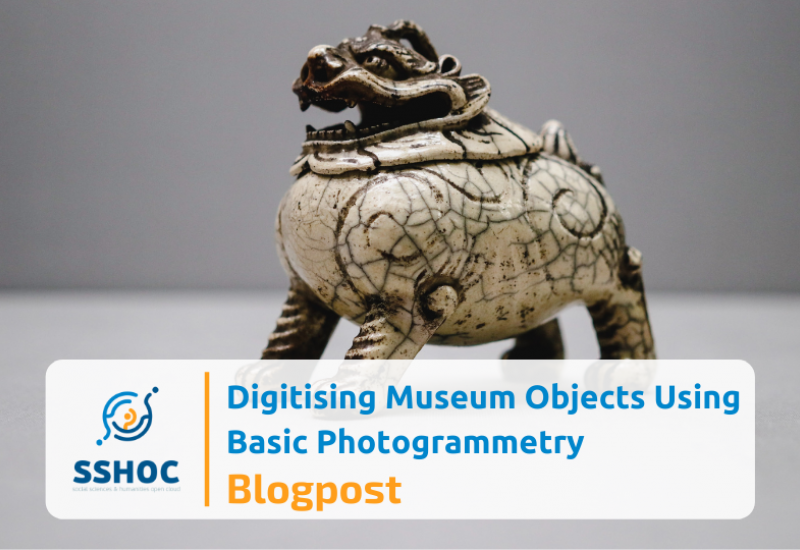
- Social Sciences & Humanities Open Cloud
SSHOC Workshop Notes: Digitizing Museum Objects Using Basic Photogrammetry

Date:
28 June 2021
There is a wide range of imaging techniques that have high potential for their application to the study, conservation and management of cultural heritage. One of these techniques is photogrammetry, the science of extracting 3D geometric data from 2D photography. The accessibility of quality digital photo cameras, including those embedded in mobile phones, makes this an affordable geometry capture technique in growing demand. SSHOC project joined forces with UCL ISH to deliver a training workshop that introduced participants to the use of photogrammetry in heritage. Through this workshop, participants were able to gain insights into the photogrammetric process. They also gained more in-depth understanding of what is achievable with basic equipment and became more aware of the requirements of 3D digitisation of museum objects and how these might differ from everyday objects.
Uncovering the secrets of a technique
The workshop started with a grounded introduction to the photogrammetry covering different aspects such as the actual technique and its usage, theoretical background, and the science behind it.
The applications of photogrammetry in heritage are many. It is increasingly used for both documentation and interpretation applications that are aided by the fast creation of 3D models. It is applied to all scales of tangible heritage, from small objects or artefacts, to full archaeological or architectual sites. 3D models can be the basis for interactive interpretation models, 3D reproductions, architectural drawings or topographical maps, among many other uses.
The scientific fundamentals rely on triangulation: photographs from at least two different locations are taken and lines of sight are established from each camera position to points on the object. Where these lines of sight intersect, three dimensional (xyz) coordinates of the point of intersection can be measured.
Applying photogrammetry to a museum object
When it comes to small and medium-size objects such as those generally found in museums, there are two ways of creating a photogrammetric model: walking around the object or using a rotational table. Both present limitations: a rotational table can only be used with movable objects of a certain size, while moving around the object doesn’t have such restrictions and can be used also for sites, but it requires a very rigorous methodology to achieve precise 3D models and repeatable results.
Some key messages regarding methodology are:
- Lighting plays a key role: diffused lighting that does not create harsh shadows is ideal. If light cannot be controlled, consider using a flash.
- Control your camera settings: shoot in .raw format, select the Adobe RGB colour space.
- Aim for the entire object to be in focus: you can use a depth of field calculator to find the right aperture for your camera, lenses and object dimensions.
- Control the light by combining shutter speed and ISO – a lower ISO is preferable, so best use a tripod to minimise image noise.
- Assess your object to identify the most challenging points – consider how many images you need to take from underneath.
- Aim for the object to take up the majority of your view, without cropping the object.
- Aim for a minimum 2/3 overlap between images and take pictures in order whenever possible.
From images to 3D models
The quality of commercial photogrammetry software is constantly improving to ensure that the most accurate model is created from the photographs at hand. There are free versions of some of these software, but typically capped by the number of photographs they can process to create the model. In case of using these free versions, photographs need to be carefully planned to cover the entire object with sufficient overlap without exceeding the maximum number of images.
Some image post-processing is typically applied to all images before inputting them into the photogrammetry software. Images are often colour-treated to soften shadow contrast, for example, in order to maximise the capabilities of the photogrammetry technique. It is recommended to carefully record any post-processing, especially when models are disseminated through Sketchfab (the YouTube of 3D models).
It is essential to remember that the quality of the 3D model will depend on the quality of the photographs. Sometimes the processing struggles to align specific images where there is not enough overlap or where there are misleading features. Identifying misaligned images and disabling or realigning them can help improve the accuracy of the model.
Photogrammetry is still an evolving technique that is constantly improving in order to overcome its limitations (e.g. capturing transparent or highly reflective surfaces). It is unquestionably gaining prominence in the heritage sector as a non-invasive, easy to use and less-costly geometry capture technique and one of the most broadly-spread imaging techniques in the sector.
Written by Alejandra Albuerne
Workshop Video
